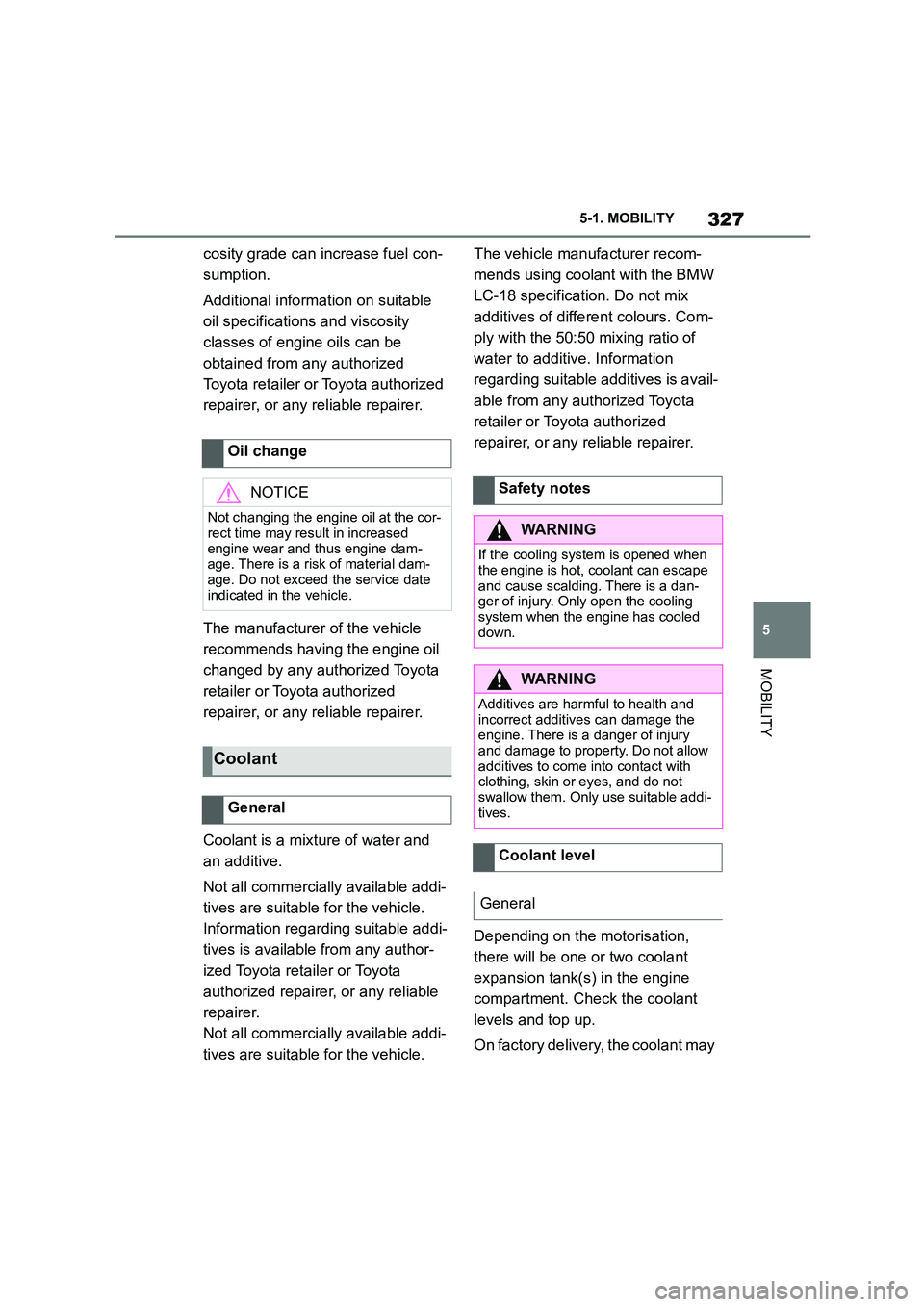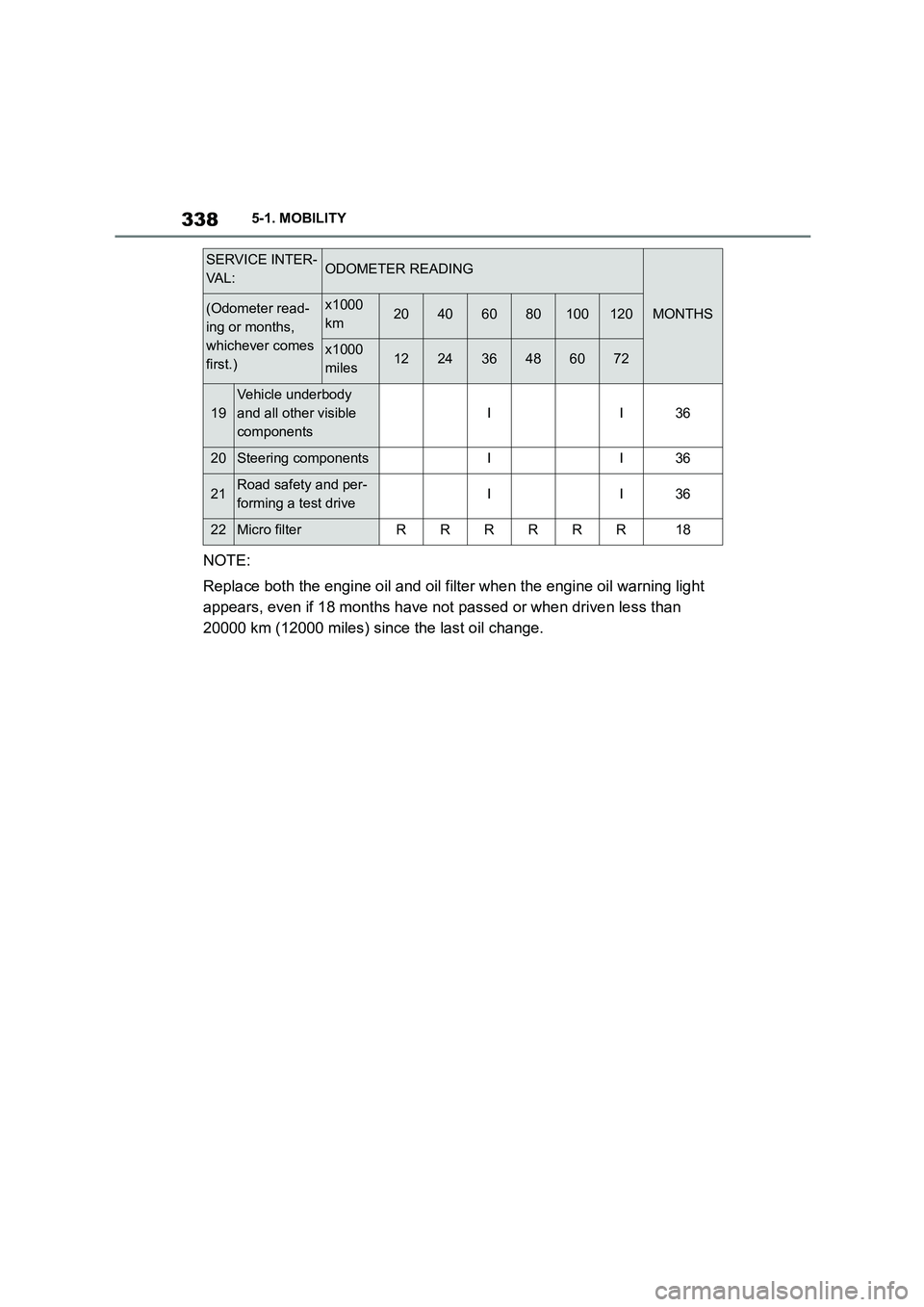2022 TOYOTA SUPRA oil
[x] Cancel search: oilPage 329 of 498

327
5
5-1. MOBILITY
MOBILITY
cosity grade can increase fuel con-
sumption.
Additional information on suitable
oil specifications and viscosity
classes of engine oils can be
obtained from any authorized
Toyota retailer or Toyota authorized
repairer, or any reliable repairer.
The manufacturer of the vehicle
recommends having the engine oil
changed by any authorized Toyota
retailer or Toyota authorized
repairer, or any reliable repairer.
Coolant is a mixture of water and
an additive.
Not all commercially available addi-
tives are suitable for the vehicle.
Information regarding suitable addi-
tives is available from any author-
ized Toyota reta iler or Toyota
authorized repairer, or any reliable
repairer.
Not all commercially available addi-
tives are suitable for the vehicle.
The vehicle manufacturer recom-
mends using coolant with the BMW
LC-18 specification. Do not mix
additives of different colours. Com-
ply with the 50:50 mixing ratio of
water to additive. Information
regarding suitable additives is avail-
able from any authorized Toyota
retailer or Toyota authorized
repairer, or any reliable repairer.
Depending on the motorisation,
there will be one or two coolant
expansion tank(s) in the engine
compartment. Check the coolant
levels and top up.
On factory delivery, the coolant may
Oil change
NOTICE
Not changing the engine oil at the cor-
rect time may result in increased
engine wear and thus engine dam- age. There is a risk of material dam-
age. Do not exceed the service date
indicated in the vehicle.
Coolant
General
Safety notes
WA R N I N G
If the cooling system is opened when
the engine is hot, coolant can escape
and cause scalding. There is a dan- ger of injury. Only open the cooling
system when the engine has cooled
down.
WA R N I N G
Additives are harmful to health and
incorrect additives can damage the
engine. There is a danger of injury and damage to property. Do not allow
additives to come into contact with
clothing, skin or eyes, and do not swallow them. Only use suitable addi-
tives.
Coolant level
General
Page 332 of 498

3305-1. MOBILITY
This chapter describes all standard,
country-specific and special equip-
ment available for the model series.
It may therefore describe equip-
ment and functions which are not
installed in your vehicle, for exam-
ple on account of the special equip-
ment selected or the country
specification. This also applies to
safety-relevant functions and sys-
tems. Please comply with the rele-
vant laws and regulations when
using the corresponding functions
and systems.
The maintenance system indicates
what maintenance measures are
required and thereby assists in
maintaining the road safety and
operational safety of the vehicle.
The exact work required and the
maintenance intervals may vary
depending on the country specifica-
tions. Replacement work, spare
parts, operating materials and wear
materials are calculated sepa-
rately. Additional information is
available from a dealer of the man-
ufacturer or another qualified dealer
or a specialist workshop.
Condition Based Service CBS
determines the maintenance
requirement using sensors and
special algorithms which monitor
the conditions in which the vehicle
is used.
The system thus enables the scope
of the maintenance work to be
adapted to the individual usage
profile.
Information on service require-
ments, see page 170, can be
shown on the Control Display.
Periods when the vehicle is out of
use with its battery disconnected
are not taken into account.
In such cases, have any
time-dependent maintenance pro-
cedures, for example for the brake
fluid and, where applicable, the
engine oil and microfilter/activated
charcoal filter, updated by a dealer
of the manufacturer or another
qualified dealer or a specialist
workshop.
Maintenance
Vehicle equipment
Maintenance System
Condition Based Service
CBS
Principle
General
Periods out of use
Page 336 of 498

3345-1. MOBILITY
Your vehicle needs to be serviced according to the normal maintenance
schedule.
Maintenance operations:
I = Inspect, correct or replace as necessary
R = Replace, change or lubricate
Scheduled maintenance (except for Europe and
Australia)
Perform maintenance by the schedule as follows:
Maintenance schedule requirements
Maintenance schedule (except for Korea, Mexico and South
Africa)
SERVICE
INTERVAL:ODOMETER READING
MONTHS(Odometer
reading or
months, which-
ever comes
first.)
x1000
km1224364860728496
x1000
miles7.214.421.628.83643.250.457.6
BASIC ENGINE COMPONENTS
1
Engine oil (Include
engine oil filter)
<
RRRRRRRR12
IGNITION SYSTEM
2Spark plugsRRRR24
FUEL AND EMISSION CONTROL SYSTEMS
3Air filterRRRR24
CHASSIS AND BODY
4Brake padsReplace when the brake warning light
appears.-
5Brake fluidFirst replace at 36 months, then replace at every 24
months.
Page 338 of 498

3365-1. MOBILITY
NOTE:
Replace both the engine oil and oil filter when the engine oil warning light
appears, even if 12 months have not passed or when driven less than
12000 km (7200 miles) since the last oil change.
Maintenance operations:
I = Inspect, correct or replace as necessary
R = Replace, change or lubricate
21Road safety and per-
forming a test driveII48
22Micro filterRRRR24
SERVICE
INTERVAL:ODOMETER READING
MONTHS(Odometer
reading or
months, which-
ever comes
first.)
x1000
km1224364860728496
x1000
miles7.214.421.628.83643.250.457.6
Maintenance schedule (for Korea, Mexico and South Africa)
SERVICE INTER-
VA L :ODOMETER READING
MONTHS(Odometer read-
ing or months,
whichever comes
first.)
x1000
km20406080100120
x1000
miles122436486072
BASIC ENGINE COMPONENTS
1
Engine oil (Include
engine oil filter) <
RRRRRR18
IGNITION SYSTEM
2Spark plugsRR54
FUEL AND EMISSION CONTROL SYSTEMS
3Air filterRR54
CHASSIS AND BODY
Page 340 of 498

3385-1. MOBILITY
NOTE:
Replace both the engine oil and oil filter when the engine oil warning light
appears, even if 18 months have not passed or when driven less than
20000 km (12000 miles) since the last oil change.
19
Vehicle underbody
and all other visible
components
II36
20Steering componentsII36
21Road safety and per-
forming a test driveII36
22Micro filterRRRRRR18
SERVICE INTER-
VA L :ODOMETER READING
MONTHS(Odometer read-
ing or months,
whichever comes
first.)
x1000
km20406080100120
x1000
miles122436486072
Page 352 of 498

3505-1. MOBILITY
This chapter describes all standard,
country-specific and special equip-
ment available for the model series.
It may therefore describe equip-
ment and functions which are not
installed in your vehicle, for exam-
ple on account of the special equip-
ment selected or the country
specification. This also applies to
safety-relevant functions and sys-
tems. Please comply with the rele-
vant laws and regulations when
using the corresponding functions
and systems.
Breakdown Assist
Vehicle equipment
If a malfunction occurs
while driving
WA R N I N G
If a malfunction occurs while driving,
immediately stop the vehicle in a safe
place.
If a warning light illuminates or flashes, or a warning message is dis-
played, immediately stop the vehicle
in a safe place. Do not open the hood to inspect the engine, as doing so
may lead to serious injury, such as
steam burns. If a warning message is displayed, perform the necessary pro-
cedures according to the displayed
message or explanation in the owner’s manual.
These warning messages indicate that a malfunction has occurred in a
system or function of the vehicle. If
you continue to drive the vehicle, the engine may stop suddenly, possibly
leading to an accident. Also, even if
no warning lights are illuminated or messages are displayed, if any
abnormal sounds, smells or vibrations
are detected, or of the engine stops suddenly, refrain from opening the
hood to inspect the engine and con-
sult any authorized Toyota retailer or Toyota authorized repairer, or any reli-
able repairer.
WA R N I N G
If you hear a loud noise or feel some-
thing impact the underside of the vehicle while driving, immediately
stop the vehicle in a safe place.
After stopping the vehicle in a safe
place, check the underside of the
vehicle for any leaking brake fluid, oil or fuel. If any fluid is leaking, stop
driving immediately and have the
vehicle inspected by any authorized Toyota retailer or Toyota authorized
repairer, or any reliable repairer.
Page 364 of 498

3625-1. MOBILITY
This chapter describes all standard,
country-specific and special equip-
ment available for the model series.
It may therefore describe equip-
ment and functions which are not
installed in your vehicle, for exam-
ple on account of the special equip-
ment selected or the country
specification. This also applies to
safety-relevant functions and sys-
tems. Please comply with the rele-
vant laws and regulations when
using the corresponding functions
and systems.
Regularly remove foreign bodies,
for example leaves, from the area
below the windscreen with the bon-
net raised.
Wash the vehicle frequently, espe-
cially in winter . Heavy soiling and
road salt can cause damage to the
vehicle.
Maximum temperature:
60°C/140°F.
Minimum distance to sensors,
cameras, seals: 30 cm, approxi-
mately 12 in.
General care
Vehicle equipment
Washing the vehicle
General
Safety notes
WA R N I N G
Damages may occur if the fuel filler
flap is open while washing. There is a risk of material damage. Close the
fuel filler flap before washing.
Remove any dirt behind the fuel filler flap with a cloth.
Steam-jet cleaners and
high-pressure cleaners
Safety note
NOTICE
When cleaning with high-pressure cleaners, excessive pressure or
excessive temperatures can damage
various components. There is a dan- ger of damage to property. Ensure a
sufficient distance and do not spray
for an extended period of time. Com-
ply with the instructions for the high-pressure cleaner.
Distances and temperature
Page 366 of 498

3645-1. MOBILITY
protects them against corrosion.
Completely remove residues on the
windscreens to avoid affecting visi-
bility due to smearing, and to
reduce wiping noise and wiper
blade wear.
Regular care promotes driving
safety and preserves your vehicle's
value. Environmental effects in
areas with high air pollution or natu-
ral contaminants, for example tree
resin or pollen, may affect the vehi-
cle paintwork. Take such factors
into consideration when deciding
on the frequency and scope of vehi-
cle care measures.
Immediately remove aggressive
substances, for example spilled
fuel, oil, grease or bird droppings so
as to prevent damage and discol-
ouration of the paintwork.
Perform the following to protect the
vehicle.
Working from top to bottom, lib-
erally apply water to the vehicle
body, wheel wells and underside
of the vehicle to remove any dirt
and dust.
Wash the vehicle body using a
sponge or soft cloth, such as a
chamois.
For hard-to-remove marks, use a
neutral detergent and rinse thor-
oughly with water.
Wipe away any water.
Never use wax or abrasive com-
pounds.
Vehicle care
Care products
Safety note
WA R N I N G
Cleaning agents can contain hazard-
ous substances or constitute a health
risk. There is a danger of injury. When cleaning the interior, open the doors
or windows. Use only products that
are intended for cleaning the vehicle's interior. Observe the notes on the
packaging.
Vehicle paintwork
General
Matt paintwork
Safety note
WA R N I N G
Work performed incorrectly on the
vehicle paintwork can cause the radar sensors to fail or malfunction, result-
ing in a safety risk. There is a danger
of accidents or damage to property. For vehicles with radar sensors, only
have paintwork or paint repairs on the
bumpers carried out by any author- ized Toyota retailer or Toyota author-
ized repairer, or any reliable repairer.